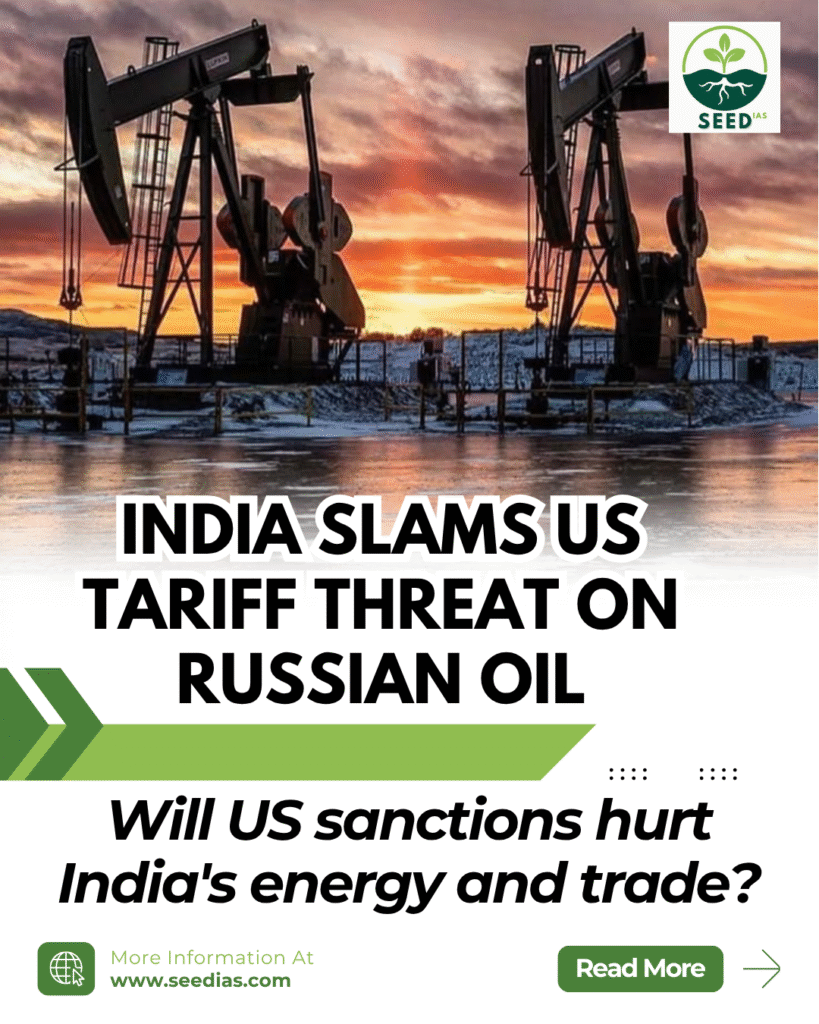Why in NEWS
India has strongly opposed the proposed US Russian Sanctions Act, 2025, which aims to impose 500% tariffs on countries importing Russian oil. The move also follows NATO warnings to India, China, and Brazil to stop buying Russian energy or face 100% secondary sanctions.
Key Terms and Concepts
| Term | Explanation |
|---|---|
| Secondary Sanctions | Economic penalties targeting third parties (countries/companies) that do business with sanctioned entities, even if those third parties have not violated international laws. |
| Primary Sanctions | Direct restrictions on a nation, entity, or person violating norms. |
| Strategic Petroleum Reserves (SPR) | Stockpiles of crude oil maintained by a country to ensure energy security during supply disruptions. |
News Summary
| Aspect | Details |
|---|---|
| India’s Reaction | Accused the West of double standards, highlighting that Europe still buys Russian energy while others are pressured to stop. |
| NATO Warning | India, China, Brazil told to halt Russian imports or face secondary sanctions. |
| Proposed Tariffs | US Sanctions Act proposes up to 500% tariffs on Russian oil importers. |
| Strategic Use of Russian Oil | India saved $13 billion by buying discounted Russian oil from 2022–2024; Russian share in India’s oil imports rose from 2.1% (FY22) to 35.1% (FY25). |
India’s Key Objections to US/NATO Sanctions
| Concern | Details |
|---|---|
| Energy Security | India imports 85% of its oil; Russian oil stabilizes inflation and CAD. |
| Double Standards | EU imported 18% of its natural gas from Russia in 2024, yet others are threatened. |
| Economic Sovereignty | 100%-500% tariffs could hurt India’s $41 billion US trade surplus and key exports like IT, pharma, and textiles. |
| Diplomatic Leverage | India sees this as a negotiation tactic, seeking exemptions or waivers from the US. |
| Historical Parallel | India was forced to stop Iranian oil imports in 2019 under similar US pressure. |
India’s Strategy to Secure Energy Future
| Focus Area | Measures |
|---|---|
| Diversification | Import from 40+ countries, incl. US, Brazil, Saudi, Iraq, Africa. |
| Strategic Reserves | Expand SPR capacity for buffer stock. |
| Renewable Push | Boost ethanol blending, biofuels, hydrogen, solar, and green energy. |
| Domestic Production | Policy reforms and PPP investment in oil & gas fields. |
| Diplomacy & Alliances | Leverage Quad, BRICS, SCO, G20, and 2+2 dialogues for waiver talks and energy partnerships. |
In a nutshell
Memory Code – ‘D-R-E-A-D’
- D – Diversify Energy Sources
- R – Build Reserves (SPR)
- E – Boost Energy Production
- A – Ally with Regional & Global Groups
- D – Resist Double Standards
Prelims Practice Questions
- Which of the following best describes “Secondary Sanctions”?
A) Sanctions targeting a country’s domestic policy
B) Penalties on third parties dealing with sanctioned entities
C) Military action on violating countries
D) Sanctions approved by UN Security Council - What percentage of India’s oil needs are met through imports?
A) 50%
B) 65%
C) 85%
D) 95% - Which of these countries was India forced to stop importing oil from due to US pressure in 2019?
A) Venezuela
B) Iran
C) Iraq
D) Russia
Mains Questions
- What are secondary sanctions? Discuss their implications on India’s energy security and economic sovereignty.10 Marks
- Critically evaluate India’s strategy in balancing geopolitical pressures and its need for energy security. 15 Marks (GS2 – International Relations, GS3 – Economy)
Answer Key – Prelims
| Q.No | Answer | Explanation |
|---|---|---|
| 1 | B | Secondary sanctions target entities dealing with sanctioned countries, not the violators directly. |
| 2 | C | India imports over 85% of its crude oil requirements. |
| 3 | B | India stopped importing oil from Iran due to US secondary sanctions in 2019. |
















